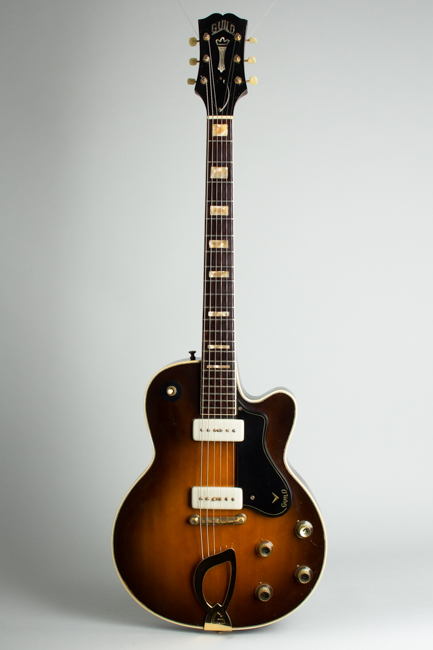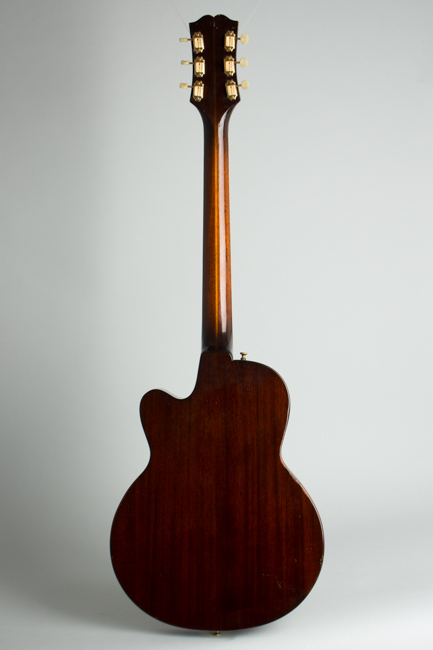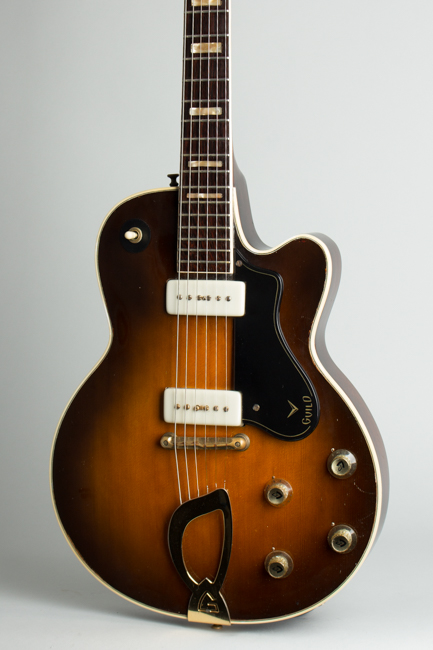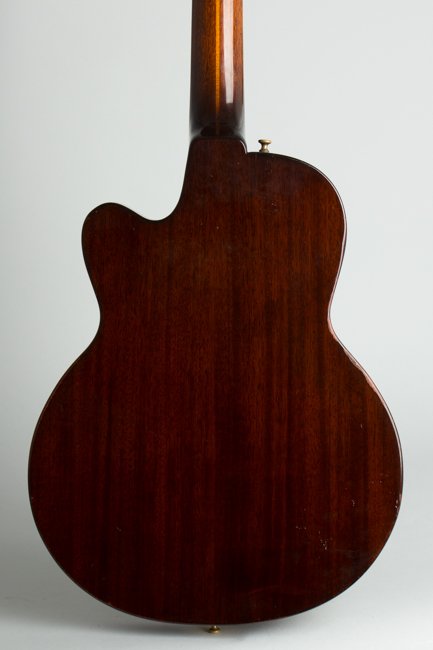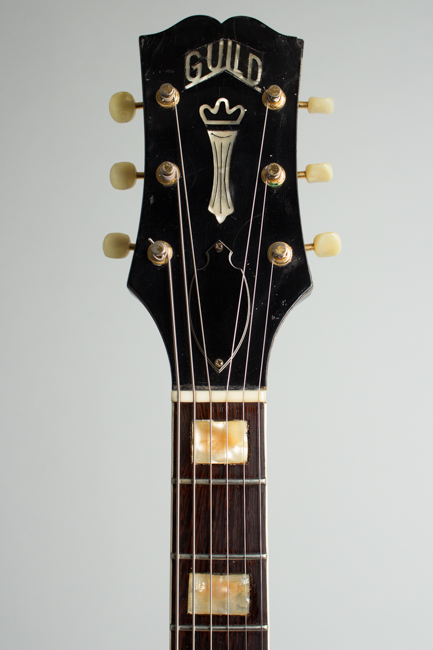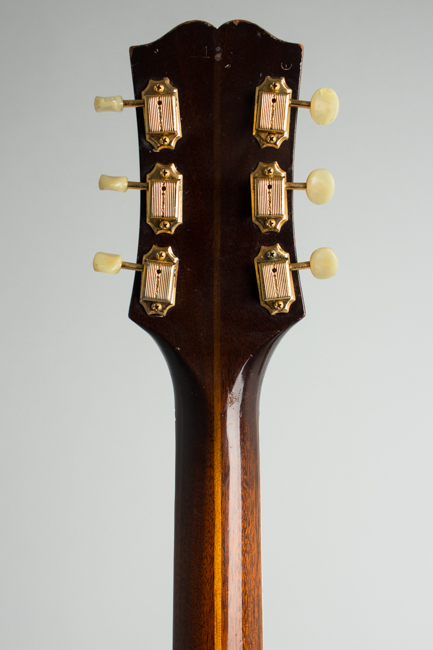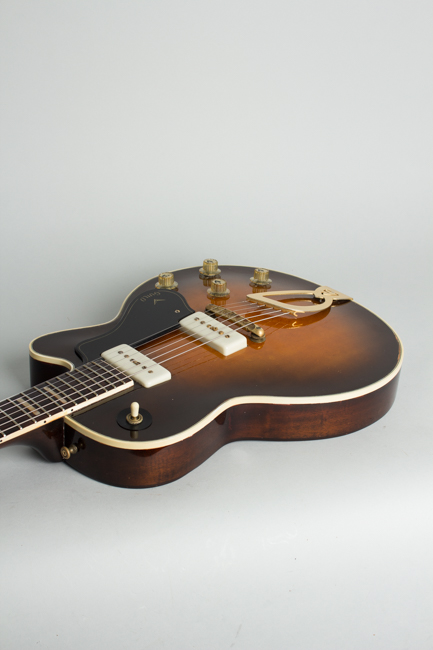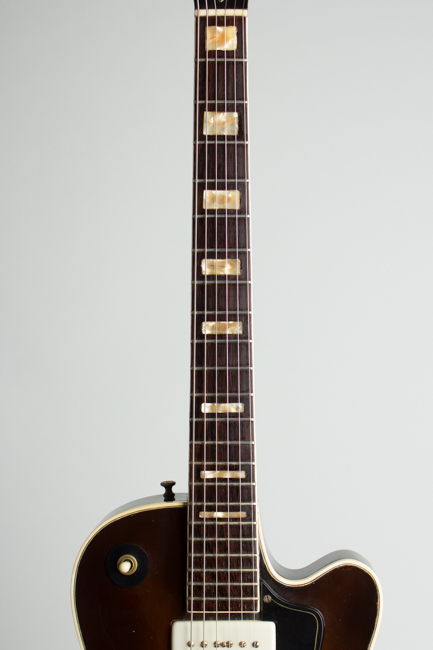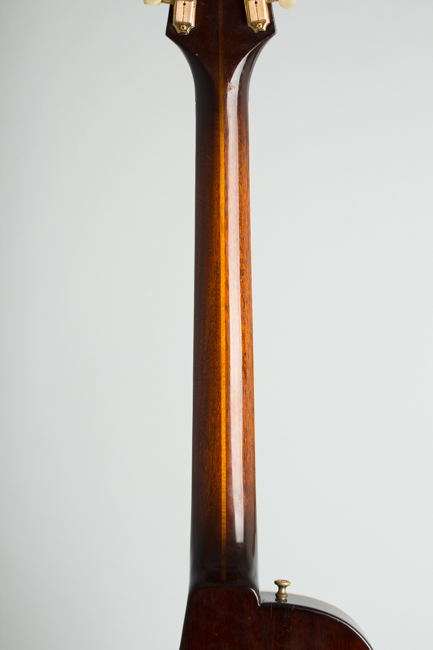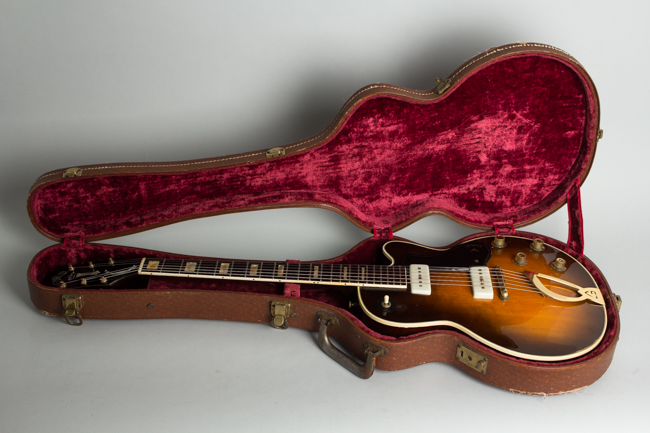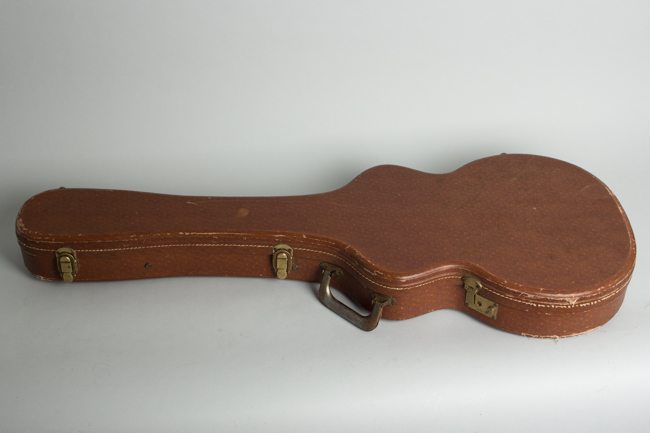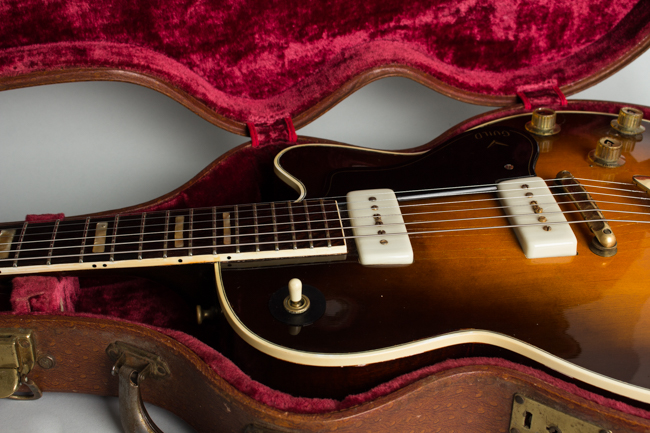Guild M-75 Aristocrat Thinline Hollow Body Electric Guitar (1959)
This item has been sold.
Item # 9582
Prices subject to change without notice.
Guild M-75 Aristocrat Model Thinline Hollow Body Electric Guitar (1959), made in Hoboken, NJ, sunburst top, dark back and sides finish, laminated mahogany body and neck, spruce top, rosewood fingerboard, original brown hard shell case.
Guild's M-75 is one of the company's most interesting original designs, their take on an idea that was kicking around New York in the early '50s -- a small semi-hollow electric guitar to compete with that new-fangled solid-body Les Paul from Gibson. Gretsch had come out with the Duo-Jet, a flashier take on the not-quite solid concept. At the time there seemed to be some resistance to the true solid-body in New York where many studio and broadcast performers worked. The archtop guitar was the preferred tool of most professionals, and the major NY-based builders -- Gretsch, Epiphone and Guild all eschewed actual solid-bodies in favor of this hybrid up into the next decade. While the M-75 looks somewhat like a Les Paul, it is much lighter with a more traditional archtop-flavored sound.
In the 1950's Guild sold an extensive line of full-sized archtop electrics, but the M-75 and its down-market sister the M-65 were arguably their most modern and distinctive offerings. Introduced in 1954 the "Aristocrat" is a classy little guitar, with higher end touches like gold plated hardware and block inlay on the bound fingerboard. The top is laminated spruce without soundholes, set over a mostly routed-out mahogany body. This gives the M-75 more of an acoustic tone quality than the Gretsch Jet series guitars that have more internal blocking.
The two pickups look like Gibson "soapbar" P-90's but were made by Fransch electronics in Woodside (Queens) NY, branded Franz. These units were standard on most 1950's Guilds; they have a lower output but a sweet and clear, somewhat microphonic response and add to the M-75's more acoustic character. The neck is mahogany with a laminated center strip and a bound rosewood fingerboard. The tuners are gold-plated individual Kluson Deluxe with the translucent plastic buttons specific to this model.
This 1959 M-75 has transitional features specific to the end of that decade; the knobs and pickguard are the newer style that would be used in the 1960's, while the small truss rod cover is still a 1950s fitting. The headstock is faced with a very early example of the plastic overlay that Guild used throughout the '60s; the "Guild" inlay is rather crudely fitted indicating they were still working through the kinks in that idea.
The M-75 was an under-appreciated instrument in its day, and never achieved the recognition it deserved. Players are often amazed at what a versatile and comfortable guitar this is. While not as much of a straight rock instrument as the Les Paul, and other solidbodies, it handles effortlessly and feels like nothing else. More than 60 years on The Aristocrat endures as a still-unique design and one of the original Guild company's finest moments.
Overall length is 39 3/4 in. (101 cm.), 13 5/8 in. (34.6 cm.) wide at lower bout, and 2 1/8 in. (5.4 cm.) in depth, measured at side of rim. Scale length is 24 3/4 in. (629 mm.). Width of nut is 1 5/8 in. (41 mm.).
Overall this is one of the nicer examples of this fairly rare model we have seen with only minor wear and retaining all original hardware. There have been some typical maintenance repairs over the years. The binding -- which is often now deteriorating badly on 1950s Guilds -- has been expertly redone on the body, with some attendant touch up on the edges. The back, sides and back of the neck have a light clear overspray added, the top remains original with some minor touch up around the binding. There is just some light average wear overall with small dings and chips; the most noticeable marks are around the rim of the unbound back.
The guitar has been refretted with slightly larger wire (wider and taller) than original style. The fingerboard inlays are the original pearloid blocks that have shrunken slightly; they have been re-set into the fingerboard with some visible fill on the edges. The fingerboard binding remains original with no notable shrinking or damage. The headstock overlay has shrunken slightly and the upper right corner has a chip missing.
The original wooden bridge top is included, but the guitar is currently set up with a TRU-ARC compensated metal saddle allowing proper intonation with an unwound G string. This is set on the original adjustable feet and the Guild bridge could easily be refitted with only a moment's work, if desired. A thin ring has been added around the rim of the pickup selector switch.
This M-75 is excellent player with a better neck angle than many with the typically distinctive sound of this model. Both original Franz pickups are strong and clear; the guitar easily shades from a jazzy purr to a sweet midrange honk into a snarling growl when the amp is cranked. A nicely preserved example of perhaps Guild's finest original design, with all required work already done to make it ready for another century. Including a very nice original brown OHSC with some wear but fully functional. Overall Excellent - Condition.
Guild's M-75 is one of the company's most interesting original designs, their take on an idea that was kicking around New York in the early '50s -- a small semi-hollow electric guitar to compete with that new-fangled solid-body Les Paul from Gibson. Gretsch had come out with the Duo-Jet, a flashier take on the not-quite solid concept. At the time there seemed to be some resistance to the true solid-body in New York where many studio and broadcast performers worked. The archtop guitar was the preferred tool of most professionals, and the major NY-based builders -- Gretsch, Epiphone and Guild all eschewed actual solid-bodies in favor of this hybrid up into the next decade. While the M-75 looks somewhat like a Les Paul, it is much lighter with a more traditional archtop-flavored sound.
In the 1950's Guild sold an extensive line of full-sized archtop electrics, but the M-75 and its down-market sister the M-65 were arguably their most modern and distinctive offerings. Introduced in 1954 the "Aristocrat" is a classy little guitar, with higher end touches like gold plated hardware and block inlay on the bound fingerboard. The top is laminated spruce without soundholes, set over a mostly routed-out mahogany body. This gives the M-75 more of an acoustic tone quality than the Gretsch Jet series guitars that have more internal blocking.
The two pickups look like Gibson "soapbar" P-90's but were made by Fransch electronics in Woodside (Queens) NY, branded Franz. These units were standard on most 1950's Guilds; they have a lower output but a sweet and clear, somewhat microphonic response and add to the M-75's more acoustic character. The neck is mahogany with a laminated center strip and a bound rosewood fingerboard. The tuners are gold-plated individual Kluson Deluxe with the translucent plastic buttons specific to this model.
This 1959 M-75 has transitional features specific to the end of that decade; the knobs and pickguard are the newer style that would be used in the 1960's, while the small truss rod cover is still a 1950s fitting. The headstock is faced with a very early example of the plastic overlay that Guild used throughout the '60s; the "Guild" inlay is rather crudely fitted indicating they were still working through the kinks in that idea.
The M-75 was an under-appreciated instrument in its day, and never achieved the recognition it deserved. Players are often amazed at what a versatile and comfortable guitar this is. While not as much of a straight rock instrument as the Les Paul, and other solidbodies, it handles effortlessly and feels like nothing else. More than 60 years on The Aristocrat endures as a still-unique design and one of the original Guild company's finest moments.
Overall length is 39 3/4 in. (101 cm.), 13 5/8 in. (34.6 cm.) wide at lower bout, and 2 1/8 in. (5.4 cm.) in depth, measured at side of rim. Scale length is 24 3/4 in. (629 mm.). Width of nut is 1 5/8 in. (41 mm.).
Overall this is one of the nicer examples of this fairly rare model we have seen with only minor wear and retaining all original hardware. There have been some typical maintenance repairs over the years. The binding -- which is often now deteriorating badly on 1950s Guilds -- has been expertly redone on the body, with some attendant touch up on the edges. The back, sides and back of the neck have a light clear overspray added, the top remains original with some minor touch up around the binding. There is just some light average wear overall with small dings and chips; the most noticeable marks are around the rim of the unbound back.
The guitar has been refretted with slightly larger wire (wider and taller) than original style. The fingerboard inlays are the original pearloid blocks that have shrunken slightly; they have been re-set into the fingerboard with some visible fill on the edges. The fingerboard binding remains original with no notable shrinking or damage. The headstock overlay has shrunken slightly and the upper right corner has a chip missing.
The original wooden bridge top is included, but the guitar is currently set up with a TRU-ARC compensated metal saddle allowing proper intonation with an unwound G string. This is set on the original adjustable feet and the Guild bridge could easily be refitted with only a moment's work, if desired. A thin ring has been added around the rim of the pickup selector switch.
This M-75 is excellent player with a better neck angle than many with the typically distinctive sound of this model. Both original Franz pickups are strong and clear; the guitar easily shades from a jazzy purr to a sweet midrange honk into a snarling growl when the amp is cranked. A nicely preserved example of perhaps Guild's finest original design, with all required work already done to make it ready for another century. Including a very nice original brown OHSC with some wear but fully functional. Overall Excellent - Condition.
